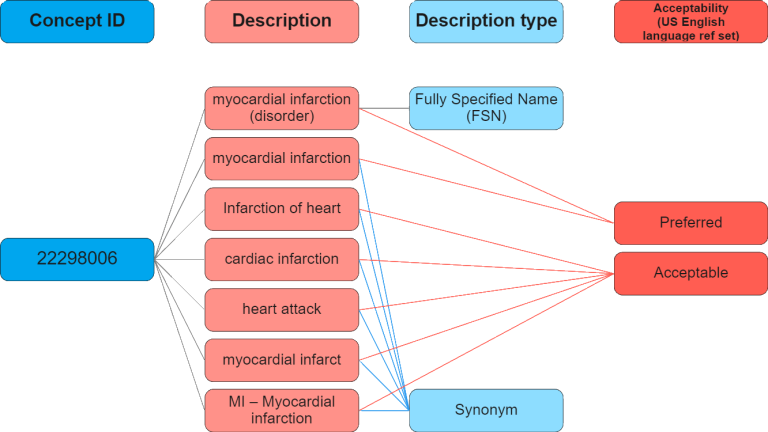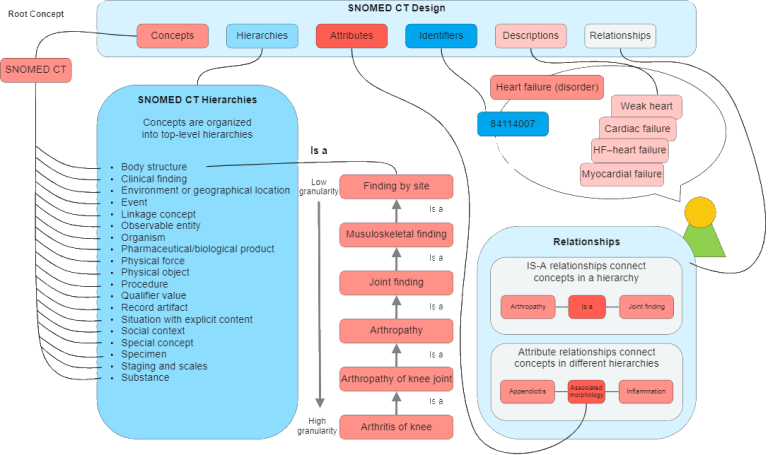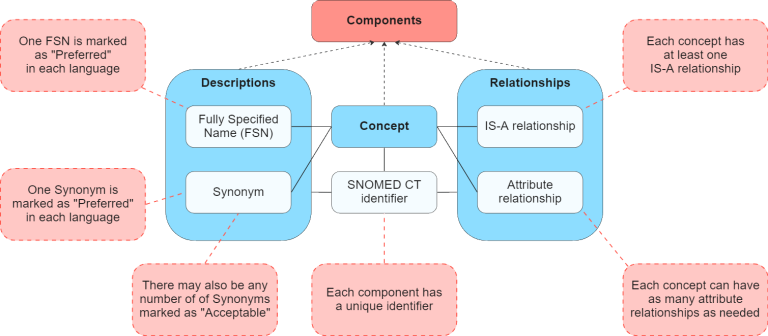What is SNOMED CT – an introduction
Healthcare organizations with a large and complex content collection should pay close attention to SNOMED CT.
Written by Vegard Ottervig on

Healthcare organizations with a large and complex content collection should pay close attention to SNOMED CT.
Written by Vegard Ottervig on
SNOMED CT (Systematized Nomenclature of Medicine – Clinical Terms) is a comprehensive clinical terminology system that provides a structured, detailed, and unambiguous way of encoding and representing clinical concepts and terms used in healthcare.
In other words: SNOMED CT makes clinical information meaningful.
The system consists of over 350,000 unique concepts or “clinical terms” and is maintained by the non-profit International Health Terminology Standards Development Organization (IHTSDO), also known as SNOMED International.
The system is used to record and share accurate and consistent information about medicine, medical/clinical conditions, and healthcare—with the ultimate purpose of improving patient care.
SNOMED CT allows healthcare providers to communicate more efficiently about a patient's condition, as it provides a standardized language for describing clinical concepts. It also enables exchange of clinical data across systems and healthcare sectors.
SNOMED CT is used in a variety of ways across the healthcare industry, including in clinical decision support systems, public health reporting, research, and quality measurement. It can also be used to support other healthcare-related activities, such as billing, administrative reporting, and healthcare analytics.
Implementing SNOMED CT as a universal health language has the potential to enhance communication among healthcare professionals, patients, and other stakeholders both within and beyond the healthcare system.
This can lead to fewer instances of patients having to repeat their information when interacting with new healthcare providers, improved monitoring and treatment of patients, and heightened patient safety. Furthermore, healthcare personnel can streamline their documentation processes and save time.
The SNOMED CT system works by organizing clinical/medical terms into a hierarchical structure of “concepts.”
The concepts in SNOMED CT are different words and expressions used in clinical settings, such as:
Each concept or clinical term in SNOMED CT is assigned a unique numerical code called a “Concept Identifier” or “Concept ID.” This code is used to identify and retrieve the clinical term in the SNOMED CT system.
Clinical terms are also given standardized names, called “Fully Specified Names,” which provide additional context and an unambiguous clarification for the term. For example, the clinical term with the concept ID “123456789” might have the Fully Specified Name “Malignant neoplasm of the breast.”
Additionally, each concept can include a multitude of synonyms. Synonyms for “malignant neoplasm of the breast” may include “breast cancer,” “cancer of breast,” “mammary cancer,” “invasive ductal carcinoma,” and “invasive lobular carcinoma.”
These synonyms may further be classified as “preferred” or “acceptable.”

In addition to its descriptions and unique numerical codes, SNOMED CT also includes relationships between concepts. These relationships define how terms are related to each other and can help to provide additional context and information about a patient's medical condition.
SNOMED CT includes “Is-a” relationships that link concepts with more general concepts higher up in the same hierarchy.
For example, a relationship might indicate that ”Malignant neoplasm of the breast” is a “Disorder of the breast” or that “Pneumonia caused by Haemophilus influenzae” is a “Bacterial infectious disease.”

There are also relationships that provide information about the attributes of the concept and that link concepts from different hierarchies together.
Breast cancer has e.g. an “Associated morphology” with “Ductal carcinoma,” and an “Anatomical location of finding” which is “Breast,” These relationships provide information about the disease process in the tissue and where the disease is located.
Relationships give meaning to concepts and help them fit into the extensive network of terms in SNOMED CT. Finally, all concepts are classified as either primitive or defined. A concept is defined when its relationships can distinguish it from all other concepts in the system.
The SNOMED CT system works by organizing the concepts into a hierarchical structure. At the top level are broad categories, such as “Body Structure” or “Clinical Finding,” which are then subdivided into more specific subcategories.
For example, under "Body Structure," there are subcategories such as "Organism" and "Tissue." Under "Organism," there are further subcategories such as "Human," "Animal," and "Bacterial." This hierarchical structure allows for easy navigation and classification of clinical terms.

Concepts can be broadened or narrowed, an example being “Injury to the knee.” A broader term could be “Injury to the leg,” while a narrower term could be “Ligament injury of the knee.”
SNOMED CT's hierarchical organization of concepts, starting from broad to specific, allows clinicians to manage information at a level of detail suitable for their needs, making it usable by various healthcare services.
This enables the detailed documentation of clinical information, which can later be retrieved and compiled at a more general level. As a result, SNOMED CT improves the quality of health data and enhances its accessibility for research and innovation.

SNOMED CT can be integrated with other widely used coding systems, such as ICPC (International Classification of Primary Care) and ICD-10 (International Classification of Diseases, Tenth Revision).
By being coded against these existing terminologies, SNOMED CT serves as a crucial bridge between established coding sets and enables easier adoption of the standardized health language across various health services.
The integration of SNOMED CT with other code sets enhances interoperability and facilitates better sharing and exchange of clinical data between healthcare providers, ultimately improving the quality and safety of patient care.
SNOMED CT is becoming increasingly important in the healthcare industry as more organizations move towards digitization and standardization of clinical information. It is a key tool for improving the quality and safety of patient care, supporting interoperability, and enabling better clinical decision making.
Get some more insights 🤓